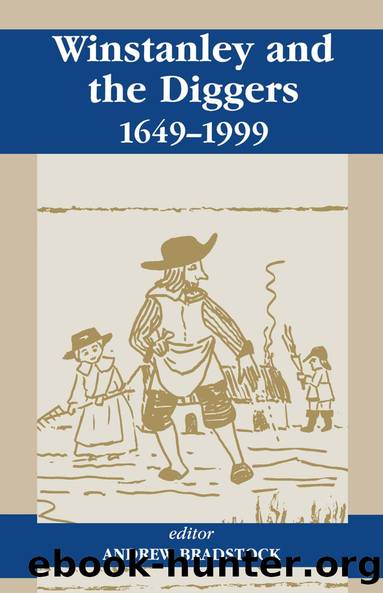Winstanley and the Diggers, 1649-1999 by Andrew Bradstock

Author:Andrew Bradstock [Bradstock, Andrew]
Language: eng
Format: epub
ISBN: 9780714681573
Barnesnoble:
Publisher: Taylor & Francis
Published: 2000-06-30T00:00:00+00:00
âThe Consolation of Israelâ: Representations of Jewishness in the Writings of Gerrard Winstanley and William Everard
CLAIRE JOWITT
On 20 April 1649 the Digger leaders Gerrard Winstanley and William Everard met with General Fairfax to explain their reasons for taking over the common land at St Georgeâs Hill earlier that month. After both refused to remove their hats, Everard acted as spokesperson for the movement, making a speech that was published within three days and widely reported in contemporary broadsheets.1
Everard said, he was of the race of the Jews; that all the liberties of the people were lost by the coming in of William the Conqueror, and that ever since, the people of God had lived under tyranny and oppression worse than that of our forefathers under the Egyptians. But now the time of deliverance was at hand, and God would bring his people out of this slavery, and restore them to their freedom, in enjoying the fruits and benefits of the earth. And that there had lately appeared to him a vision, which bade him arise, and dig and plough the earth, and receive the fruits thereof; that their intent is, to restore the creation to its former condition.2
This essay uses Everardâs extraordinary claim of Jewish self-identity as a way of exploring Digger beliefs about Jews. Everardâs statement that âhe was of the race of the Jewsâ is examined in relation to other contemporary Digger publications, specifically Winstanleyâs Truth Lifting up its Head above Scandals (written in response to Everardâs imprisonment at Kingston in 1648), The New Law of Righteousnes (1649) and The True Levellers Standard Advanced (published at the same time as the meeting with Fairfax in April 1649) which was signed by fifteen Diggers, including Winstanley and Everard (whose name is first). Everardâs âJewishnessâ is also placed in the context of the snowballing mid-century debate over Jewish readmission in which â for the first time since the expulsion of Jews from England in 1290 â English theologians, politicians and writers seriously debated the merits of a native English Jewish population.3 What this essay seeks to establish, then, is the extent to which Everard and Winstanley were using an historical Israelite identity as a metaphor for their own political, religious and social aims and situation. It also examines whether beliefs and knowledge concerning contemporary practising Jews â which were starting to be widely circulated in England for the first time in three hundred and fifty years â were implicated in this parallel and, if so, what this tells us concerning the Diggersâ attitudes to Jews.
In the pamphlets The New Law of Righteousnes and The True Levellers Standard Advanced, in particular, an Israelite identity is important since â as we have already seen in Everardâs speech â the Diggers used the captivity of the Israelites under the Egyptians as a parallel to that of the English people downtrodden by the legacy of William the Conqueror. In The True Levellers Standard Advanced, for example, this political point is made especially forcefully since
Download
This site does not store any files on its server. We only index and link to content provided by other sites. Please contact the content providers to delete copyright contents if any and email us, we'll remove relevant links or contents immediately.
Verus Israel: Study of the Relations Between Christians and Jews in the Roman Empire, AD 135-425 by Marcel Simon(569)
Phoenicians among Others: Why Migrants Mattered in the Ancient Mediterranean by Denise Demetriou(568)
Caesar Rules: The Emperor in the Changing Roman World (c. 50 BC â AD 565) by Olivier Hekster(550)
Europe, Strategy and Armed Forces by Sven Biscop Jo Coelmont(494)
Give Me Liberty, Seventh Edition by Foner Eric & DuVal Kathleen & McGirr Lisa(463)
Banned in the U.S.A. : A Reference Guide to Book Censorship in Schools and Public Libraries by Herbert N. Foerstel(461)
american english file 1 student book 3rd edition by Unknown(455)
Reading Colonial Japan by Mason Michele;Lee Helen;(453)
The Roman World 44 BC-AD 180 by Martin Goodman(451)
DS001-THE MAN OF BRONZE by J.R.A(437)
The Dangerous Life and Ideas of Diogenes the Cynic by Jean-Manuel Roubineau(428)
The Oxford History of World War II by Richard Overy(427)
Imperial Rome AD 193 - 284 by Ando Clifford(426)
Basic japanese A grammar and workbook by Unknown(426)
Introducing Christian Ethics by Samuel Wells and Ben Quash with Rebekah Eklund(425)
Literary Mathematics by Michael Gavin;(385)
Language Hacking Mandarin by Benny Lewis & Dr. Licheng Gu(365)
How to Reach the 9.0 in IELTS Academic Reading by IELTS Medical(350)
The Oxford History of the Renaissance by Campbell Gordon;(342)
